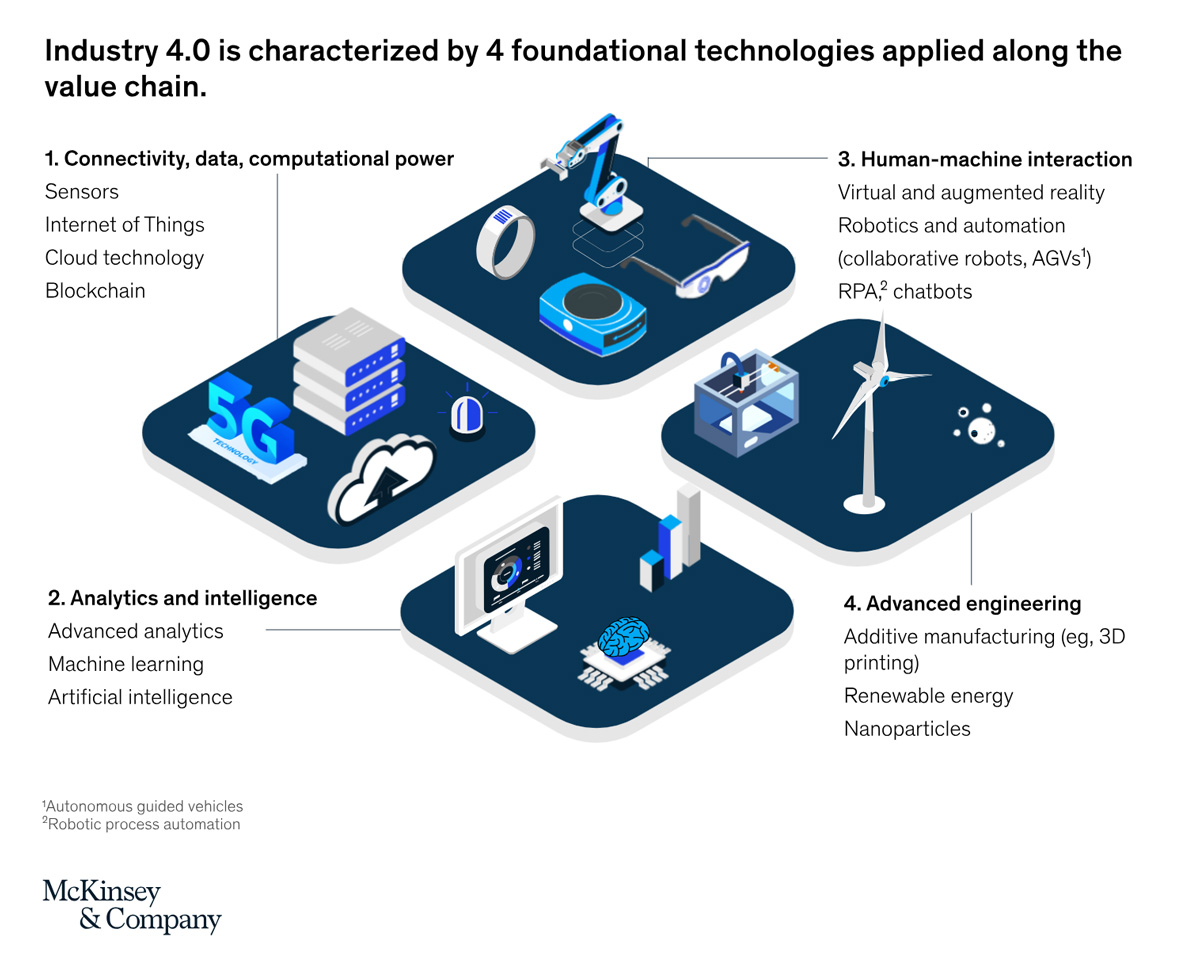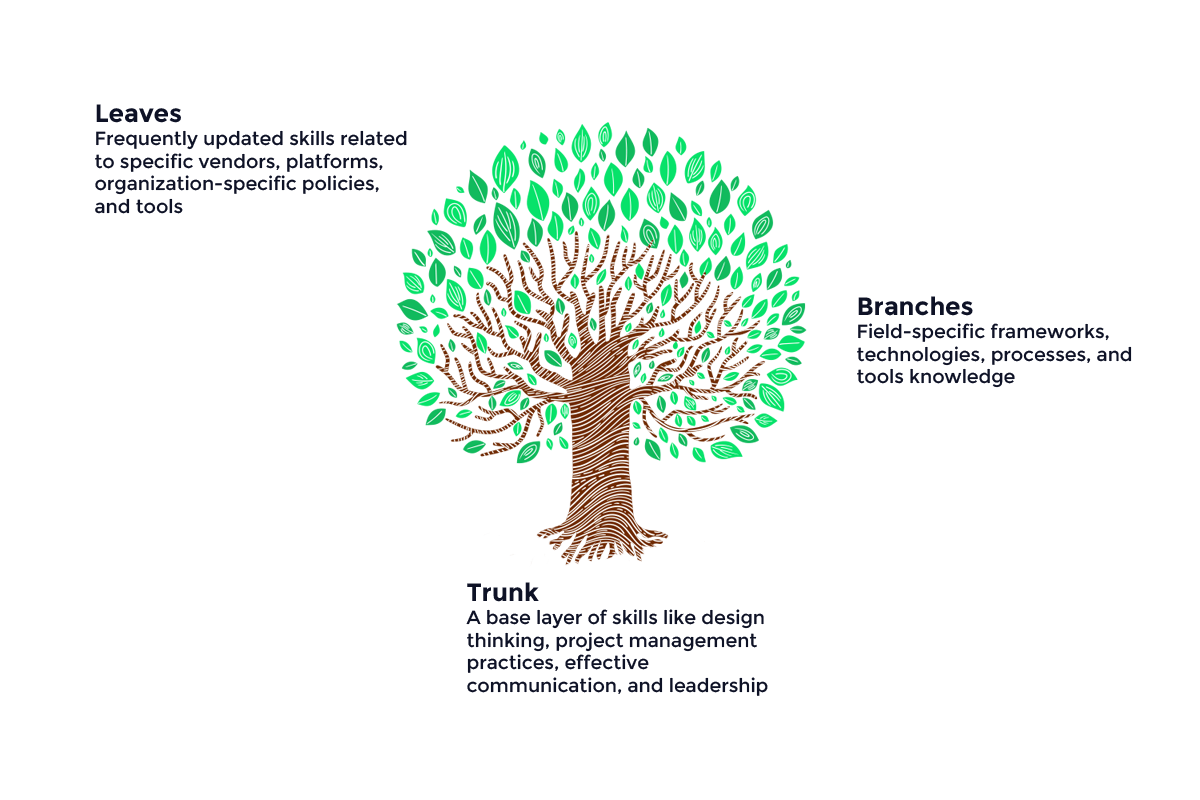How often do you audit your team's skill set and update corporate training programs accordingly? If you've answered once in over two years, you are probably setting yourself up for failure, especially if you're dealing with technical competencies.
Research done by IBM in 2019 suggests that skills generally have a "half-life" of about five years, with more technical skills at just two and a half years, meaning that the value of those skills would decline by half — or half the knowledge associated with the skills would become irrelevant.
Moreover, they've estimated that over 120 million workers in the world's 12 largest economies might have needed to be retrained/reskilled in the following three years as a result of AI-enabled automation. It's more than the entire labor forces of Canada and Brazil combined.
The economy and workforce changes are accelerating, and the reason for that is the Fourth Industrial Revolution (or 4IR) — the convergence of disruptive technological advancements:
- Digitalization: The rapid expansion of the internet and digital technologies transforming how we communicate, work, and live.
- Automation: Artificial intelligence (AI), robotics, and other automation technologies displacing humans from a wide range of tasks.
- Data Analytics and Big Data: Harnessing the power of data insights for informed decision-making.
- Connectivity: The Internet of Things (IoT) connecting devices and systems in ways that were not possible before.
While 4IR affects some economic sectors more profoundly than others at the moment, the ripple effect will reach everyone. For example, the World Economic Forum's Future of Jobs Report 2023 found that up to 85 million jobs could be lost to automation and artificial intelligence (AI) by 2025, but that 97 million new jobs could also be created. Just imagine the scale of worker displacement it can cause and the depth of transformation it will require from public, educational, and business sectors to accommodate.
Securing one's place at the forefront of this transformation can make or break the success of an organization. According to a 2018 McKinsey Global Institute analysis, 4IR front-runners can expect a 122% positive cash flow change, while follower companies can expect just 10%, and companies failing to adopt AI could see a 23% downturn.

The issue is that a company is as prepared for these changes as its employees are, so companies facing squarely the challenge of reimagining the ways of professional development — upskilling and reskilling — have much better chances to succeed in this turbulent future.
What shortens the skills' "shelf-life"?
Computers, the internet, and manufacturing automation have been around for decades. Why do they suddenly affect skill longevity so much? Many factors contribute to the case, both socio-economic and technological:
Global competition
The world economy is becoming increasingly globalized, which means that businesses are competing with companies from all over the world and looking for the most efficient and cost-effective ways to operate. This often means automating or outsourcing tasks to countries with lower labor costs, which pressures workers in developed countries to lower their wages or upgrade their skills to remain competitive.
Changing workforce demographics
The workforce is aging, and there is a shortage of young workers to replace them due to several factors, including declining birth rates, longer lifespans, and a shift away from manufacturing and toward service industries. This shortage of workers is putting pressure on businesses to find ways to automate tasks or make better use of existing workers.
The rise of the gig economy
The gig economy based on short-term contracts and freelance work makes it more difficult for workers to build stable careers and develop long-term skills. As a result, workers have to adapt to a more fluid and uncertain job market and frequently reskill and upskill to remain competitive.
The shift in skills demand
Until recently, companies had fixed teams, top-down decision-making processes, clear objectives, and structured work orders. The dynamic digital era requires an agile approach, horizontal and flexible team structures, and decision-making through experiments and iterations. Naturally, it pushed forward a different set of skills needed from a team to work efficiently in this new environment, i.e., so-called soft skills and highly technical skills. Both require way more prolonged learning, and the latter also change rapidly. As a result, from 2014 to 2018, the period it took to close the skill gap through traditional learning increased 12-fold, from 3 days to 36 days.
Rapid technological advancement
The pace of technological advancement is now outpacing our ability to keep up with, adapt, and acquire new skills. McKinsey & Company identified four technologies the 4IR is based on:

In concert, they allow us to automate creative and analysis-heavy tasks that we previously thought only humans could do — monitor the machinery state, produce high-precision equipment, find non-obvious ways to optimize the workflow, forecast demand and supply, finetune logistics, write simple code, come up with a new product idea and marketing campaign for it, with all the texts and imagery, etc.
The combined impact of these factors is making it way more difficult for workers and organizations to stay relevant than ever before.
The impact of short-lived skills on companies
When technology changes faster than an employee can finish a training course, the company inevitably faces a skills gap problem. This lack of proper upskilling and reskilling can create many adversities for the company's future:
Reduced productivity
Outdated ways are inefficient, so when employees' skills turn obsolete, the company loses out on improved workflows, and its productivity suffers. This can impact the company's bottom line and make it difficult to compete in the market.
Inability to innovate
The skills gap also hinders the company's ability to innovate and adopt new technologies and market trends, as it relies on employees who can adequately leverage them. When a company's workforce lacks the skills needed for product or service innovation, it will struggle to adapt quickly to changing demands and keep offerings relevant in the market, leading to declining competitiveness.
High employee turnover
Being aware that their skill set is insufficient and not getting adequate professional development opportunities, employees feel stuck, undervalued, and frustrated. This can negatively impact morale and team dynamics and push employees to leave the company to seek better opportunities elsewhere, leading to higher turnover rates and a loss of institutional knowledge. And there's no guarantee the company will be able to find a replacement.
In fact, by 2030, the talent shortage can reach more than 85 million people globally.
The WEF predicts that 44% of workers' skills will be disrupted between 2023 and 2028, while according to ManpowerGroup, in 2018 already, 45% of organizations couldn't find the skills they needed (67% for large employers), and over two-thirds of companies were forced to lower their requirements to fill positions.
So, tackling the skills gap means competing with virtually everybody else. In other words, in such a tight labor market as ours, relying solely on sourcing relevant talent outside is unsustainable and, frankly, unattainable. Retain and retrain — this is the way.
Changing the training approach
With skills becoming obsolete quickly, companies must repeatedly invest in training and reskilling their employees, so choosing the right strategy is paramount for the company's bottom line. Complicating matters further, no one really knows what to prepare for.
67% of executives expect that automation will require roles and skills that don't even exist today.
What we do know is the following:
- Just as the work processes become more agile, the training approaches need more flexibility, too.
- Training should be scalable.
- Adjusting to constant changes requires systemic skill building.
- While many skills come and go, some essential baseline competencies allow one to build new skills more quickly.
Now, let's take a closer look at each point.
Agility
A rapidly and unpredictably evolving landscape calls for training approaches to mirror the same agility seen in work processes. A one-size-fits-all training model is no longer effective. Instead, companies should adopt flexible training methods that can monitor and quickly adapt to address emerging skill demands. This might involve a shift from traditional classroom-style training to more dynamic and interactive online learning modules and microlearning.
Scalability
As the need for upskilling and reskilling becomes a constant, training programs must be scalable, ensuring that training initiatives can accommodate the evolving needs of the workforce. This could involve using Learning Management Systems (LMS) to deliver scalable, on-demand training resources.
Also, as the workforce becomes more distributed, companies must be able to deliver training to employees anywhere and anytime. It requires a scalable and cost-effective training platform that can provide access to training materials in various formats, e.g., a cloud-based LMS that delivers training to a global workforce and makes it easy to update training materials and track employee progress.
Systematic approach
Knowing how uncertain the landscape is, it's tempting to focus on short-term training to help employees get up to speed quickly. However, companies can't afford a haphazard approach to training.
Instead, they should establish systematic skill-building aligned with the company's strategic goals. This comprehensive training plan must cover a range of skills and incorporate ongoing assessment, transparent feedback loops, and regular updates to ensure that employees have complete visibility into the market needs and are continuously acquiring relevant skills, making it easier to adapt to the evolving demand. Systematic skill building also helps to ensure that employees can transfer their skills to new roles and responsibilities.
Building a solid skill base
Given the rapid obsolescence of many skills, a more strategic approach to skill development is needed. This approach involves cultivating a tree-shaped skills development model, where durable and transferable foundational skills form the trunk, upon which various specialized skills can grow.

The foundational skills, like critical thinking, problem-solving, communication, and adaptability, are the enduring roots that will serve employees well in the dynamic and ever-evolving workplace. Specializations, like programming languages, software tools, or technical skills, represent the branches and leaves of the tree. These specialized skills are more susceptible to becoming obsolete but can be quickly taught if needed.
By embracing flexibility and approaching upskilling and reskilling proactively and systematically, companies will be better equipped to navigate the uncertainties of the evolving workplace and remain competitive in the global economy.
E-learning as a major upskilling and reskilling facilitator
E-learning is a powerful tool to address the skills gap challenges, offering a flexible, accessible, and engaging means for acquiring new skills and knowledge.
Continuous learning
E-learning platforms provide a seamless and convenient means for delivering educational content, catering to lifelong learning demands.
E-learning also enables efficient tracking and management of learning processes. This detailed data can be used to assess individual learning needs and tailor instruction accordingly, ensuring that learners are on track to achieve their goals and allowing for targeted interventions where necessary. Moreover, with an LMS, the training materials can be easily updated in real-time to reflect industry trends, technologies, and skill requirements changes. Through interactive modules, video tutorials, and live webinars, learners can stay abreast of the latest field developments, ensuring their skills remain relevant and competitive.
Agility and flexibility
One of the hallmark advantages of e-learning is its ability to offer education anytime, anywhere. Learners can access a vast array of courses, modules, and training resources at their own pace and schedule, eliminating the geographical limitations and time constraints often associated with traditional classroom-based learning.
E-learning platforms also facilitate personalized education, tailoring content to individual needs and schedules. Learners can focus on areas relevant to their professional development goals which require more attention, and organizations can design training adapted to their specific industry needs.
Collaboration and networking
E-learning extends beyond individual learning experiences, fostering collaboration among learners. Through discussion forums, virtual classrooms, and collaborative projects, individuals can share insights, discuss challenges, and collectively enhance their understanding. This collaborative approach breaks down social barriers and promotes knowledge sharing, enriching the learning experience and fostering a sense of community among learners.
Such LMS features also create networking opportunities, facilitating mentorship, job shadowing, and potential career advancement opportunities, enriching the learning journey and providing valuable connections in the professional sphere. This allows learners to gain practical perspectives, industry insights, and real-world applications of their newly acquired skills.
E-learning's ability to foster continuous learning, adapt to industry needs, and nurture collaboration among learners and professionals makes it an invaluable tool for individuals and organizations seeking to ensure their market relevance in the long term.
Empowering tomorrow's workforce
The Fourth Industrial Revolution is well underway. Intelligent automation, fueled by artificial intelligence and machine learning, is poised to revolutionize industries and transform the nature of work.
While automation poses challenges in some areas, it also presents opportunities to redefine work processes and create new opportunities. The choice for organizations is to either ride the wave of innovation or drown in its wake. To succeed in the 4IR, one needs a workforce equipped with the skills and agility to thrive in a rapidly changing world. Continuous learning, upskilling, and reskilling, thus, are no longer a luxury but a necessity.
If you want to join the ranks of forward-thinking organizations empowering their workforce for the future, contact us today and learn how Opigno LMS can help you build the talent ready to conquer the challenges and seize the opportunities of the Fourth Industrial Revolution.
Published on December 19, 2023.